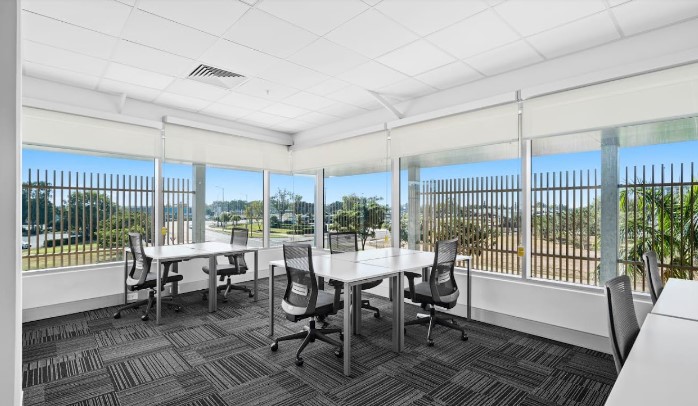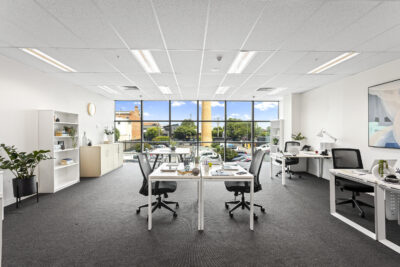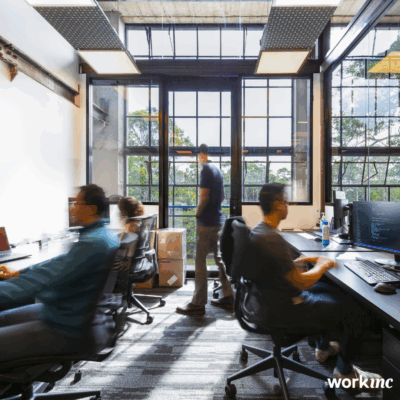Understanding Activity-Based Working (ABW)
Activity-Based Working (ABW) is a workplace design strategy that moves away from the traditional assigned desk model, offering employees multiple settings tailored to different work activities. Rather than assigning a fixed desk, employees can choose from a variety of spaces, such as collaborative spaces, quiet rooms, meeting spaces, and phone booths, depending on their task at hand. This approach enhances employee satisfaction by providing flexibility, autonomy, and a work environment that supports diverse work styles.
Originating from Dutch consultant Erik Veldhoen, the concept of ABW recognises that employees perform a wide range of activities throughout the day, from focused work and private calls to group meetings and brainstorming sessions. By designing an office space that accommodates these different tasks, businesses can improve productivity, increase engagement, and foster a more agile working culture.
Activity-Based Working vs. Traditional Office Design
Workplace design has evolved significantly over the years, with businesses shifting from rigid, traditional office layouts to more flexible and dynamic environments. Activity-Based Working (ABW) challenges the conventional office model by prioritising adaptability, employee autonomy, and efficient space utilisation. Below is a comparison of traditional office layouts and ABW office design.
Traditional Office Layout
- Fixed seating arrangement
- Hierarchical structure
- Limited flexibility
- Higher real estate costs
Activity-Based Working Office Design
- No assigned desks
- Spaces designed for different activities
- Encourages movement and collaboration
- More efficient use of space
The Evolution from Traditional Work Culture to Activity-Based Workplaces

Image source: https://flexfind.com.au/listing/100-harris-street-pyrmont/
For many years, office environments followed a rigid structure where employees had assigned desks within open-plan spaces. While this setup worked for some, it often failed to account for the varying needs of employees performing different activities effectively. Traditional office design emphasised efficiency but lacked flexibility, limiting the ability of employees to move between different spaces suited to their tasks.
In contrast, an activity-based workspace encourages flexible working by providing employees with the right technology and a variety of work settings supported by an agile workplace design. This cultural shift acknowledges that not all tasks require the same physical space, allowing employees to choose an environment that best supports their work, whether it’s a private space for deep focus or an open plan desk for casual collaboration.
Key Elements of an Activity-Based Working Office

1. Multiple Settings for Different Tasks
An effective ABW office includes a range of activity settings that cater to various job roles and responsibilities. These work settings might include:
- Collaborative Spaces: Designed for teamwork and brainstorming sessions, these areas encourage creativity and innovation.
- Quiet Rooms: Ideal for focused work or individual tasks that require concentration without distractions, like phone booths for calls.
- Meeting Rooms: Equipped for structured discussions, formal meetings, or presentations.
- Open Plan Desks: On-demand seating arrangements that encourage casual interactions and networking among employees.
By offering different spaces tailored to employees’ needs, companies ensure that their workforce remains productive, engaged, and able to complete tasks efficiently.
2. Technology Integration for Seamless Hybrid Working
For an ABW office to function effectively, it must be supported by the right technology. Hybrid working models, where employees split their time between remote and in-office work, require digital tools that facilitate seamless communication and collaboration. Cloud-based solutions, digital booking systems for meeting spaces, and smart office technology help manage space usage and maintain efficiency in a flexible work environment.
Employers must invest in the necessary infrastructure to support remote access, video conferencing, and document sharing, ensuring that employees can transition between different work settings without disruption. This not only enhances workplace experience but also improves productivity and workflow efficiency.
3. Improved Employee Experience and Work-Life Balance
One of the major benefits of activity-based working is the positive impact on employee satisfaction and work-life balance. By allowing employees to work in whichever spaces best suit their needs, ABW fosters autonomy and engagement, leading to a healthier office environment. Employees no longer feel restricted to an assigned desk; instead, they can move between spaces that optimise their comfort and efficiency.
Additionally, providing employees with the freedom to choose their work environment can reduce stress levels, improve focus, and encourage a more dynamic and interactive workplace culture. Whether employees need a quiet zone for deep work or a meeting space for collaboration, ABW ensures that they have access to the right physical space at the right time.
4. Cost Savings and Space Optimisation
ABW is not just about improving the employee experience—it also leads to cost savings for businesses. Traditional offices often dedicate unnecessary space to assigned desks that remain unused for large portions of the day. By shifting to an activity-based workplace, companies can optimise office space, reducing real estate costs while still providing an effective working environment.

Image source: https://flexfind.com.au/listing/1-palerston-circuit-palmerston/
Hybrid offices that embrace activity-based workspace principles can downsize office footprints, reallocating resources towards enhancing workspace design and investing in better technology. This approach not only benefits businesses financially, but also contributes to a more sustainable use of office resources.
Key Benefits of an Activity-Based Workspace
Activity-Based Working (ABW) offers a range of advantages that go beyond flexibility. By tailoring work environments to specific tasks, businesses can enhance productivity, improve employee well-being, optimise office space, and foster greater collaboration. Additionally, ABW promotes sustainability by reducing unnecessary resource consumption. Below are some of the key benefits of adopting an activity-based workspace.
1. Enhanced Productivity
By providing different types of workspaces, ABW encourages employees to work in environments that best support their tasks. This leads to increased efficiency and better focus.
2. Improved Employee Well-Being
A mix of collaborative and quiet spaces helps reduce stress, improve work-life balance, and boost morale. Employees feel more engaged and in control of their workday.
3. Cost Savings on Office Space
With fewer assigned desks, companies can reduce office size and optimise real estate costs. This is particularly beneficial for growing startups and enterprises looking to scale efficiently.
4. Increased Collaboration and Innovation
An activity-based working office design fosters spontaneous interactions, brainstorming sessions, and cross-functional teamwork, leading to more innovative solutions.
5. Sustainable and Eco-Friendly Design
ABW reduces the overall footprint of office spaces, cutting down on energy consumption, furniture waste, and operational costs.
Is Activity-Based Working Right for Your Business?
Startups and SMEs alike can benefit from ABW, but successful implementation depends on company culture, work dynamics, and business needs. If your team thrives on flexibility, collaboration, and autonomy, an ABW activity-based workplace could be the key to unlocking higher productivity and employee satisfaction.
Final Thoughts
Activity-Based Working is more than just a trend—it’s a transformational shift in workplace strategy. By embracing an activity-based working office design, businesses can create an adaptable, cost-efficient, and engaging work environment that aligns with modern workforce expectations. Whether you’re launching a startup or managing a growing enterprise, adopting an activity-based workspace can future-proof your office and elevate team performance.
If you’re looking to implement ABW in your office, consider exploring flexible office spaces in major Australian cities, such as Sydney, Melbourne, Brisbane, Perth, or Adelaide. These locations offer modern office designs tailored to enhance collaboration and productivity in any work environment.



